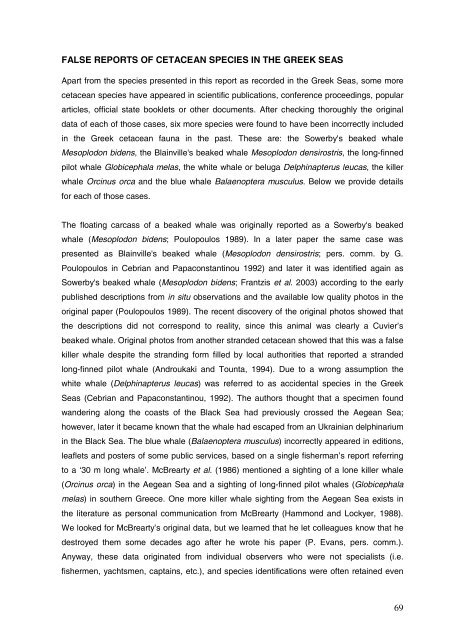Cetaceans in Greece: Present status of knowledge
Cetaceans in Greece: Present status of knowledge
Cetaceans in Greece: Present status of knowledge
You also want an ePaper? Increase the reach of your titles
YUMPU automatically turns print PDFs into web optimized ePapers that Google loves.
FALSE REPORTS OF CETACEAN SPECIES IN THE GREEK SEAS<br />
Apart from the species presented <strong>in</strong> this report as recorded <strong>in</strong> the Greek Seas, some more<br />
cetacean species have appeared <strong>in</strong> scientific publications, conference proceed<strong>in</strong>gs, popular<br />
articles, <strong>of</strong>ficial state booklets or other documents. After check<strong>in</strong>g thoroughly the orig<strong>in</strong>al<br />
data <strong>of</strong> each <strong>of</strong> those cases, six more species were found to have been <strong>in</strong>correctly <strong>in</strong>cluded<br />
<strong>in</strong> the Greek cetacean fauna <strong>in</strong> the past. These are: the Sowerby's beaked whale<br />
Mesoplodon bidens, the Bla<strong>in</strong>ville's beaked whale Mesoplodon densirostris, the long-f<strong>in</strong>ned<br />
pilot whale Globicephala melas, the white whale or beluga Delph<strong>in</strong>apterus leucas, the killer<br />
whale Orc<strong>in</strong>us orca and the blue whale Balaenoptera musculus. Below we provide details<br />
for each <strong>of</strong> those cases.<br />
The float<strong>in</strong>g carcass <strong>of</strong> a beaked whale was orig<strong>in</strong>ally reported as a Sowerby's beaked<br />
whale (Mesoplodon bidens; Poulopoulos 1989). In a later paper the same case was<br />
presented as Bla<strong>in</strong>ville's beaked whale (Mesoplodon densirostris; pers. comm. by G.<br />
Poulopoulos <strong>in</strong> Cebrian and Papaconstant<strong>in</strong>ou 1992) and later it was identified aga<strong>in</strong> as<br />
Sowerby's beaked whale (Mesoplodon bidens; Frantzis et al. 2003) accord<strong>in</strong>g to the early<br />
published descriptions from <strong>in</strong> situ observations and the available low quality photos <strong>in</strong> the<br />
orig<strong>in</strong>al paper (Poulopoulos 1989). The recent discovery <strong>of</strong> the orig<strong>in</strong>al photos showed that<br />
the descriptions did not correspond to reality, s<strong>in</strong>ce this animal was clearly a Cuvier’s<br />
beaked whale. Orig<strong>in</strong>al photos from another stranded cetacean showed that this was a false<br />
killer whale despite the strand<strong>in</strong>g form filled by local authorities that reported a stranded<br />
long-f<strong>in</strong>ned pilot whale (Androukaki and Tounta, 1994). Due to a wrong assumption the<br />
white whale (Delph<strong>in</strong>apterus leucas) was referred to as accidental species <strong>in</strong> the Greek<br />
Seas (Cebrian and Papaconstant<strong>in</strong>ou, 1992). The authors thought that a specimen found<br />
wander<strong>in</strong>g along the coasts <strong>of</strong> the Black Sea had previously crossed the Aegean Sea;<br />
however, later it became known that the whale had escaped from an Ukra<strong>in</strong>ian delph<strong>in</strong>arium<br />
<strong>in</strong> the Black Sea. The blue whale (Balaenoptera musculus) <strong>in</strong>correctly appeared <strong>in</strong> editions,<br />
leaflets and posters <strong>of</strong> some public services, based on a s<strong>in</strong>gle fisherman’s report referr<strong>in</strong>g<br />
to a ‘30 m long whale’. McBrearty et al. (1986) mentioned a sight<strong>in</strong>g <strong>of</strong> a lone killer whale<br />
(Orc<strong>in</strong>us orca) <strong>in</strong> the Aegean Sea and a sight<strong>in</strong>g <strong>of</strong> long-f<strong>in</strong>ned pilot whales (Globicephala<br />
melas) <strong>in</strong> southern <strong>Greece</strong>. One more killer whale sight<strong>in</strong>g from the Aegean Sea exists <strong>in</strong><br />
the literature as personal communication from McBrearty (Hammond and Lockyer, 1988).<br />
We looked for McBrearty’s orig<strong>in</strong>al data, but we learned that he let colleagues know that he<br />
destroyed them some decades ago after he wrote his paper (P. Evans, pers. comm.).<br />
Anyway, these data orig<strong>in</strong>ated from <strong>in</strong>dividual observers who were not specialists (i.e.<br />
fishermen, yachtsmen, capta<strong>in</strong>s, etc.), and species identifications were <strong>of</strong>ten reta<strong>in</strong>ed even<br />
69


